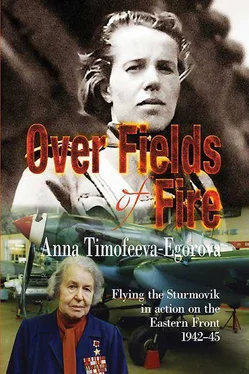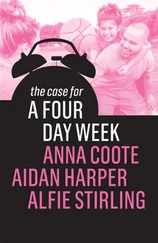“What’s the name of the gunner you want to get rid of?”
“Makosov.”
“Give him to me.”
“I strongly advise against it, Comrade Lieutenant”, the adjutant remarked.
“Send him to my plane anyway, please”, I requested.
Soon enough, I was talking at the parking lot with Squadron Engineer Shourkhin and Technician-Lieutenant 132 132 Editor’s note — a line used to indicate a corresponding auxiliary branch of military service (technician-lieutenant; engineer-rear-admiral; colonel, medical service, etc.).
Stepanov, when a chuckle sounded behind me: “Here I come!”
I glanced back and there stood a boy about eighteen years old at the most, with a round face split by a smile, which dimpled his tight pinkish cheeks. His field cap was pushed onto the back of his head, and the forelock of his fair hair was accurately combed to one side.
“Who are you?” I asked him.
“Sergeant Makasov. Adjutant Boiko had, you know… Had sent me to you…”
“So what? Report your arrival, Sergeant Makosov!”
“It’s kinda odd. It’s the first time I’ve seen a female pilot!” And he began to giggle again, shifting from foot to foot, obviously a stranger to standing at attention.
“What for did they send you to our regiment?”
“I am an air gunner”
“Have you ever flown before?”
“I completed a gunnery course and that was it…”
“Do you want to fight as a gunner?”
“I want it very much but they’re not assigning me a pilot.”
“Do you know well the hardware of the cockpit? Gunnery techniques? Silhouettes of the hostile planes?”
“I do!”
“Alright then. I’ll test you tomorrow.”
The next day in the morning I saw Makosov in the Sturmovik cockpit. During questioning he answered fluently and never stopped smiling. And so it came to pass that we started going on combat missions together.
Personally, I myself would never ever have agreed to be an Il-2 aerial gunner. It was scary! The gunner sat with his back to the pilot in an open cockpit. In front of him there was a half-ring mount with a heavy machine gun. When a Fascist fighter got on your tail and started shooting at you — how could someone withstand it?! After all, an aerial gunner had neither a trench nor a hump of earth behind which he might hide from enemy bullets. Of course he’s got his machine-gun but it is the pilot who controls the plane throwing it from one side to another and it doesn’t make the gunner’s life easy. It may also happen that the machine-gun jams due to malfunction or because it has run out of ammunition 133 133 Editor’s note — the normal combat load of ammunition for the rear 12.7-mm machine-gun in an Il-2 was just 250 rounds.
… No, no way would I want to be aerial gunner in a Sturmovik .
However, Makosov started behaving quite actively right from his very first sorties. Spotting an enemy plane he would immediately shoot a flare at it, warning everyone of danger. When I was gaining in altitude after completing my pass over the target, Makosov would fire his gun to hit a target of opportunity on the ground. I knew that the tail of my plane was covered in a reliable way. Moreover, using an intercom set my air gunner was always reporting whatsoever he saw in the air or over the ground.
“Comrade Lieutenant”, I heard time and again now. “A flak gun’s firing from the woods on the right!” or “Comrade Lieutenant, six tanks are moving towards ‘Lesser Land’ from Novorossiysk. They’re shooting on the move!” And yet again: “Comrade Lieutenant, Sturmovik tail number ‘6’ is hit. It is loosing altitude, going down to the sea…”
It seemed nothing could escape the attention of my gunner. I was happy for his successes and used every opportunity to support or praise him. For completing 10 combat missions successfully and for damaging a Messer, the regimental HQ awarded Makosov the medal ‘For Meritorious Service in Combat’.
My air gunner always kept his heavy machinegun in combat-ready order. He always cleaned and lubricated it in time, performed maintenance check-ups and prevented any jams. Makosov would sit in the Sturmovik cockpit for hours and practise by targeting planes flying over the aerodrome. By that time, I had full confidence in him. I was fairly sure: in a difficult situation he will not get lost, will not let me down. Makosov never panicked, never got overexcited. He shot in a calm, business-like manner — and did hit his target. Over the Stanitsa Moldavankaya he managed to shoot down a Me-109, jointly with few other gunners. Soon, Makosov was awarded with another medal ‘For Valour’. During debriefings he was now being held up as an example for other gunners, but he invariably kept smiling the same way, showing the dimples on his cheeks and blushing. I noticed that our gunsmith and weapon/ammunition specialist girls started looking towards our Sturmovik with quite an interest — it was Makosov sitting in its cockpit…
I have to mention that all the girls serving in our regiment were the pick of the bunch — very pretty. Masha Zhitnyak, Yulia Panina, Masha Dragova, Varya Matveeva, Nina Gneusheva, Dousya Nazarkina, Lida Fedorova, Lyuba Kasapenko. Nina Piyuk, Katya Kozhevnikova, Nina Shcwetz, Katya Zelinskaya — they all had come from ShMAS 134 134 School for Junior Aviation Specialists.
. All of them were locals, from the Kuban area, — it turned out that when we were based in the area the local Military Commissariat had sent them all to us as a bunch. The girls were supervised by armament technicians P. I. Panarin and N. A. Kalmykov, and also by our armament engineer B. D. Sheiko. The days when we were conducting missions in a rapid sequence were incredibly difficult for the girls. How many bombs and rockets they had to lug to a plane! And not just lug but lift and suspend them — and do so without any appliances. It was also their responsibility to load hundreds of cannon and machinegun belts between the sorties, and to fuel every plane scheduled for a combat mission. All that was so impossibly hard that for many years after the war they could not carry a child… Many male technicians would help the girls voluntarily: after completing their own duties.
At the same time, the arrival of the ‘best half of the people’ in the regiment had surely influenced our male contingent. Prior to the appearance of the girls many pilots of our regiment considered it fashionable to wear a beard. Although it might not have been a fashion but rather a superstition: a bullet will not find you once you have a beard! But once our pretty gunsmiths and weapon/ammunition specialists had arrived — all those beards disappeared overnight, as if they were gone with the wind. The pilots started shaving and changing their clothesmore often, and the technicians followed their example. Their usually oily and dirty overalls became almost snow-white due to washing in buckets of petrol. Some appeared ironed — these were placed under a mattress for a night.
The fact that Technician-Lieutenant Petr Panarin wasn’t indifferent to the armament specialist Masha Zhitnyak was noticed in the regiment straightaway. What could you do about it? — he had fallen in love with her at first sight. Petr was attracted to this quiet unhurried Ukrainian girl by her modesty, kindness, diligence, and without procrastination (lest the dashing pilots beat him to it!) he proposed. But… he was rejected. And after a repeated proposal Maria said as if cutting him off: “You, Comrade Technician-Lieutenant, think I came to the regiment to get married? I won’t hide that I like you, but there’ll be no wedding until the day of our Victory!”
Many years later, after the war, our former armament specialist Maria Timofeevna Zhitnyak (now her last name was Panarina) came to visit me in Moscow. She was living in the city of Chervonograd, close to Lvov. She was as always smiling and cordial as before, although the war and age had certainly left their mark on her. We were able to recall a lot during that encounter: how mistrustfully our regimental comrades treated the girls, how hard their life was at the beginning. Indeed, not everything went smoothly for the female armament specialists at first. And how hard it was for them… It is true that not everything went right in the beginning: many girls just did not know to use the tools, and their hands were covered with bruises. But nobody heard any complaints from them! Knowing it was not easy for many, the girls reconciled themselves to all the hard sides of frontline life.
Читать дальше












